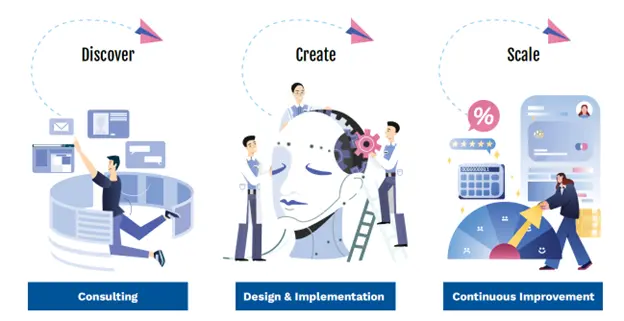Introduction
In the digital and connected age, adopting digital transformation has become a necessity for organizations. It requires ongoing investment in technology, skills, and leadership to continuously adapt to changing market conditions and customer expectations. Large-scale digital initiatives are often hampered by misalignment between business strategy and technology, poor leadership, and resistance to change. So, what separates failures from success?
Adopting a strategic and systematic roadmap can help organizations overcome challenges and achieve a successful and lasting transformation. Understanding key stages and implementing best practices can help organizations better navigate the complexity of this change.
At eInfochips, we follow a three-step process to implement our clients’ digital transformation journeys. The three-step framework—Discover, Create, and Scale—provides a clear, structured path for enterprises embarking on digital transformation. eInfochips has also created frameworks and accelerators at each of these stages, enabling businesses to achieve tangible outcomes at every stage of their transformation journey.

1. Discover: Laying the Groundwork for Transformation
The first phase of digital transformation begins with Discover. Before embarking on any digital initiative, businesses must have clarity on the end goal: Is the objective to optimize existing processes or rapidly transform the business model?
This stage is focused on understanding where the business stands, identifying opportunities for improvement, and aligning the digital transformation strategy with organizational goals.
eInfochips has created a Digital Discovery Assessment framework that can help organizations understand their existing systems, processes, and technologies. It consists of five key analyses: product assessment, cost-benefit analysis, digital migration, business impact analysis, and technology assessment.
The business impact analysis evaluates the potential impact of digital transformation on key business outcomes such as revenue growth, customer experience, and operational efficiency. It enables executives to assess the Return on Investment (ROI) of the digital initiatives and fine-tune the roadmap for execution. By analyzing these business impacts upfront, organizations can prioritize initiatives that will deliver the most value in the set timelines.
In addition, eInfochips has also created various accelerators such as DevOps Maturity Assessment, Cloud Migration and Optimization Assessment, and Cybersecurity Assessment Frameworks to enable clients to successfully evaluate the existing infrastructure and implement the digital transformation plan.
DOWNLOAD CASE STUDY
IoT Platform Development for Connected F&B Appliances| eInfochips Case Study
2. Create: Design and Development
The Create phase is where strategy transforms into action. This stage focuses on actual design, development, and implementation of digital solutions that will enable the businesses to achieve their transformation goals.
Successful transformation often incorporates a broad range of technologies and services such as cloud, Devops, IoT, data analytics, machine learning, generative AI, robotic process automation, blockchain, extended reality, and cybersecurity.
Legacy architecture modernization plays a significant role in this phase. Many organizations still rely on outdated systems that hinder agility and limit the potential of new technologies. Modernization of this legacy infrastructure is essential to supporting the new solutions, enabling greater scalability, and future-proofing the organization’s technological landscape.
eInfochips has developed in-house frameworks such as EIC Propel and Conxero. While EIC PROPEL™ provides a powerful and adaptable solution for managing connected assets, Conxero offers the resources needed to develop a complete end-to-end IoT system. Our offering of accelerators and reusable assets helps de-risk and speed up digital transformation implementations while lowering cost and complexity for their clients.
3. Scale: Optimizing Business Operations
The final phase is where the organization reaps the rewards of its digital transformation efforts. With the right technologies in place, organizations can expand their operations, enter new markets, and better serve customers.
After the initial implementation, businesses require ongoing technical support to maintain system uptime, troubleshoot issues, and implement updates. Partnering with managed service providers ensures that the organization has the resources and expertise to continuously optimize the digital environment.
Sustenance services ensure that the system continues to function effectively over the long term. This includes regular updates, security updates, and optimization efforts to keep up with technological advances and business requirements. By investing in sustenance, organizations ensure that their transformation remains relevant as market demands evolve.
The key KPIs and metrics assessed at this stage include mean time to respond/resolve, uptime, latency, failure rate, service delivery rate, incident resolution time, and deployment success rate.
DOWNLOAD CASE STUDY
Cloud Monitoring and Optimization for Consumer Electronics | eInfochips Case Study
A cohesive, organization-wide approach to digital transformation ensures all departments are aligned with the broader vision. Rather than treating digital transformation as a standalone project, it should be the core driver of business decisions, influencing the organization’s vision, objectives, and competitive advantage.
Establishing a comprehensive monitoring framework allows organizations to track the impact of digital initiatives. Successful digital transformation uses data-driven insights to continuously optimize operations and strategies. Regular feedback from employees, customers, and partners helps identify areas for improvement and refine digital approaches.
Conclusion
Digital transformation is a complex, multi-stage process that demands careful planning, strategic alignment, and continuous optimization. The key to success lies in having a clear ambition, a solid design, agile delivery, a scalable solution, and a commitment to continuous refinement. Organizations that invest in the right leadership, workforce empowerment, and ongoing iterations are far more likely to succeed in their digital transformation efforts, avoiding the pitfalls that have led to failures. With a holistic approach, organizations can unlock the true potential of digital transformation and emerge stronger, more resilient, and ready to meet the demands of the digital age.
Know More: Devops Services













